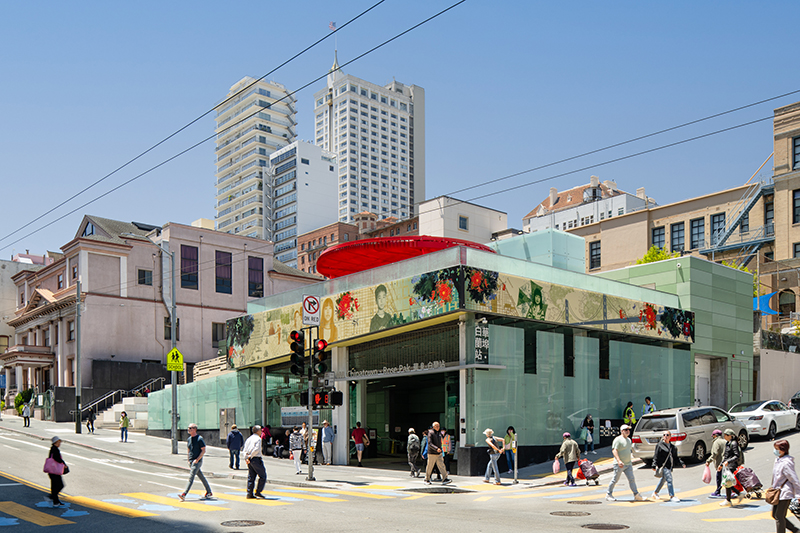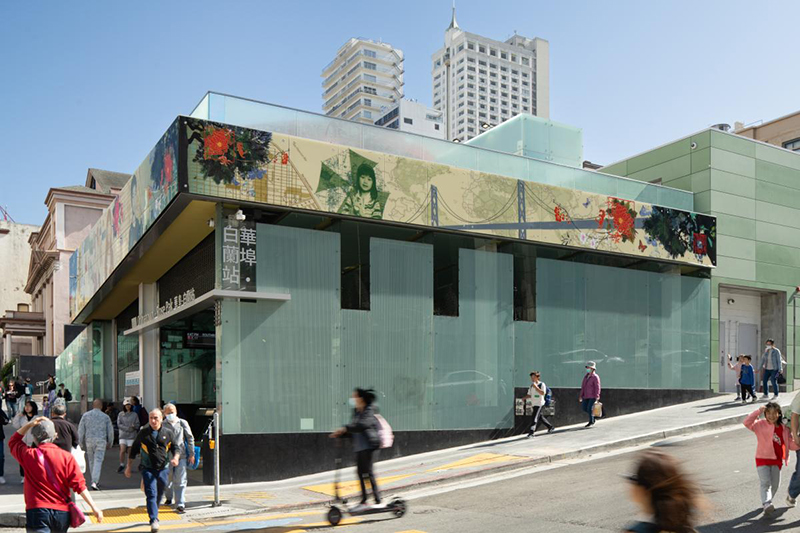
On July 24, the San Francisco Arts Commission (SFAC), San Francisco Municipal Transportation Agency (SFMTA), city officials and community leaders celebrated the completed installation of the first phase of a new permanent architecturally-integrated glass art installation at Chinatown-Rose Pak Muni Station that illustrates and celebrates the culture and history of the surrounding area and Chinatown neighborhood.
Arrival, created by New York-based artist and activist Tomie Arai, presents the story of San Francisco’s Chinatown through historic and contemporary imagery translated into architectural glass on the station’s parapet façade along Stockton and Washington streets, as well as along the station’s plaza wall.
“This project serves as an illustration of the immigrant experience and the history of San Francisco," says Mayor Daniel Lurie. “In addition to being a transit and community hub, Chinatown-Rose Pak Station will now welcome residents and visitors alike with incredible art. This mural exemplifies the rich culture of San Francisco and how immigrants throughout history have helped shaped Chinatown and our city.”

Glass and artwork details
The artwork at the façade of Chinatown-Rose Pak Station is approximately 120 feet in length with a height ranging from 4 to 8 feet, totaling approximately 700 square feet. The artwork glass was fabricated by Moon Shadow Glass with support from Magnolia Editions. The installation of the artwork was made possible with the help of San Francisco Public Works, which led construction management.
At the entrance into the Muni station, the artwork extends like a scroll across the three sides of the station’s parapet, beginning with scenes of the California coast and San Francisco Bay—a historic port of entry for immigrants from Asia. As the artwork turns onto Stockton Street and then Washington Street, the design portrays a mix of hybrid trees and flowers, suggesting a garden and the promise of a new home, a reference to the Ping Yuen (Peaceful Garden) public housing project and the legacy of Chinatown tenant organizers. Maps of local streets, the broader city and the world beyond form an evolving backdrop for portraits of students from Gordon J. Lau Elementary School and multiple generations of community members. Arrival signifies a neighborhood in transition, rich with history and moving towards a more global future.
What people are saying
"Rose Pak Station is emerging as a vital hub for transportation and community life in Chinatown. Tomie Arai’s new artwork at the station reflects the Asian American experience while highlighting the powerful intersection of art, identity, and social activism,” says Danny Sauter, Supervisor of District 3. “The artwork, Arrival, will undoubtedly enrich the cultural vibrancy of this historic neighborhood.”
"With the completion of Phase I of Arrival by Tomie Arai at Chinatown-Rose Pak Station, the often-untold and overlooked stories of Asian American contributions to San Francisco will now help beautify this dynamic and resilient neighborhood," says Ralph Remington, Director of Cultural Affairs. "We are proud to see this site-specific work, one that is reflective of the surrounding community, come to life and serve as a living archive for future generations to come. Thank you to SFMTA and Public Works for their partnership and collaboration in helping install this monumental work."
“Both art and public transit have the ability to move and connect us, and this showstopping, thoughtful installation sits at the intersection of the two,” says Public Works Director Carla Short. “We are thrilled to have been able to play a part in bringing this project to life, helping add another layer of beauty, history and kinship to this community’s already rich cultural tapestry.”
What's next?
The second phase of Arrival will be installed in early 2026 on the platform level of the station with glass panels approximately 17 feet wide and 15 feet high at each end of the platform. These works draw upon historical imagery illustrated through the traditional symbols for heaven and earth in Chinese culture – the circle and square. On the north platform wall, Arai includes images of the early settlement of San Francisco, the gold rush, immigration to the United States through Angel Island and the great earthquake. On the south platform, the work celebrates the resilience of the community of Chinatown and greater San Francisco through a collage of images from 1906 to the present.